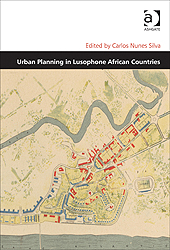Urban Planning in Lusophone African Countries

This edited collection compares urban planning in the colonial and postcolonial eras of Lusophone Africa. The premise is that it is difficult to understand current and future conditions of planning in these countries without knowing their political and infrastructural histories. Mozambique receives the most attention, but Angola, Guinea-Bissau, São Tomé and Príncipe, and Cape Verde are also covered.
There are four main research questions:
· What are the similarities and differences of colonial urban planning across these five countries?
· How did Portuguese colonialism integrate urban planning?
· What are the postcolonial planning practices of the former Portuguese colonies?
· How are the Portuguese-speaking countries of Africa engaging with, and challenging, their colonial planning legacies?
The chapters that explore colonial planning demonstrate the complexity of colonial logic, which changed according to the political regime and the influence of different schools of thought on urbanism. They also show the interdependence of colonialism and planning. For instance, Portuguese authorities in Maputo used strategic urbanization to justify their “civilizing” project. This allowed rural areas to be ordered according to European planning ideas and Portuguese cultural habits.
The chapters on the postcolonial period show the diversity of planning practices that emerged in the region following independence. Clearly, this is a contentious subject. Competing actors have distinct ideas for how to use urban space, in light of postcolonial ideologies of socialism, neoliberalism, etc.
A thought-provoking case study examines the naming and renaming of spaces in Maputo. This has been a charged topic since independence, when Mozambique’s first president rejected the Portuguese name given to the capital: “Lourenço Marques is dead, our city is called Maputo”. Maputo referred to both a river and a historical name for the territory, and was thus a symbolic rejection of the Portuguese-imposed order. In contrast to other suggestions for replacing the colonial name, Maputo was free of associations with a particular regional or ethnic grouping.
The new name given to the capital was accompanied by the renaming of towns, streets, public buildings, and outdoor spaces. This was explicitly framed as a revolutionary act. Heroes of the Occupation Square became Mozambican Heroes Square; Princess Patricia Street was renamed Salvador Allende Avenue.
Despite the revolutionary intentions behind this urban reimagining, this chapter argues that the new names maintained elite foundations. These new appellations neglected women’s role in Mozambican history, venerated a certain kind of (male) revolutionary violence, and did not match the unofficial names that ordinary residents used for the city’s landmarks. In effect, they erased the people’s history – in a way that echoed the colonizers’ erasing of non-European history in an earlier era.
From this perspective, place names in Maputo are not trivial. They reflect and perpetuate certain views of the past and particular aspirations for the future. In Maputo, this may have been complicated by a suspicion of urbanism, given the Portuguese privileging of urban spaces as sites of European modernity. It will be interesting to see how the city’s urban naming continues to transform in the future – could Kim Il Sung Avenue be joined by Kim Jong Un Plaza?
Further reading:
Jenkins, Paul (2000), “Urban management, urban poverty and urban governance: planning and land management in Maputo”, Environment and Urbanization Vol 12, No 1, pages 137–152, available at http://eau.sagepub.com/content/12/1/137.abstract.
Porter, Libby (2006), “Planning in (post)colonial settings: challenges for theory and practice”, Planning Theory and Practice Vol 7, No 4, pages 383–396, available at http://core.ac.uk/download/files/42/81391.pdf.
Book note prepared by Christine Ro
Search the Book notes database
Our Book notes database contains details and summaries of all the publications included in Book notes since 1993 - with details on how to obtain/download.
Use the search form above, or visit the Book notes landing page for more options and latest content.
For a searchable database for papers in Environment and Urbanization, go to http://eau.sagepub.com/

